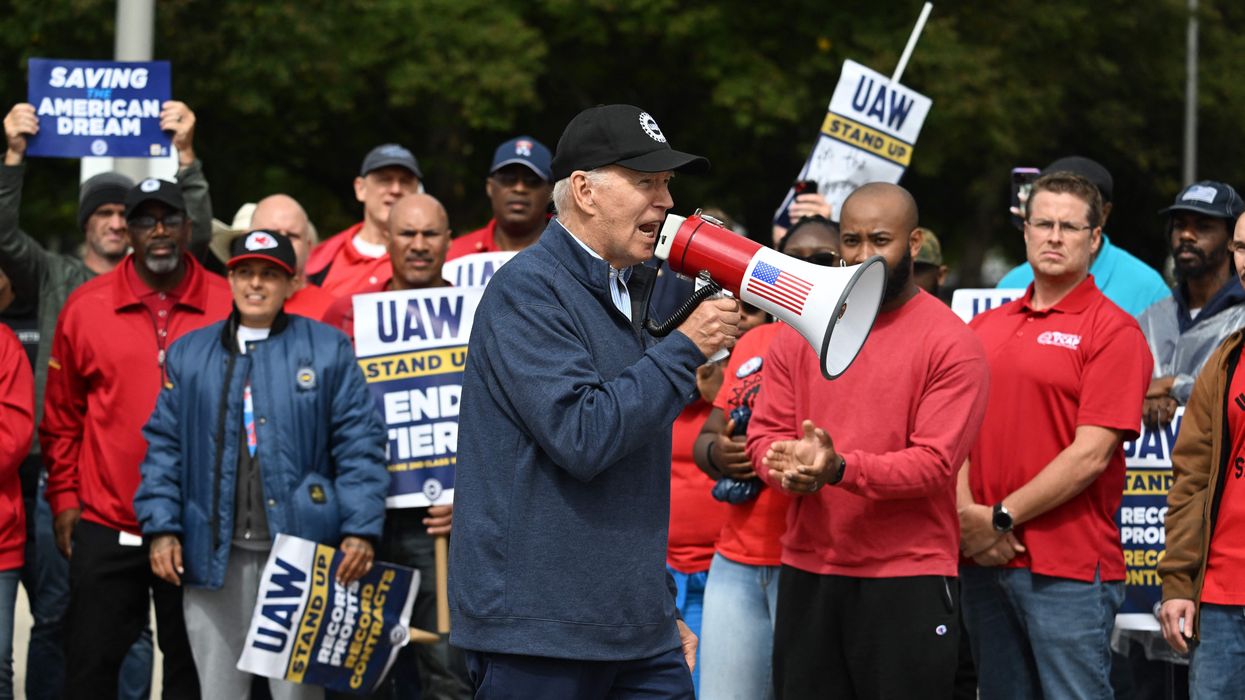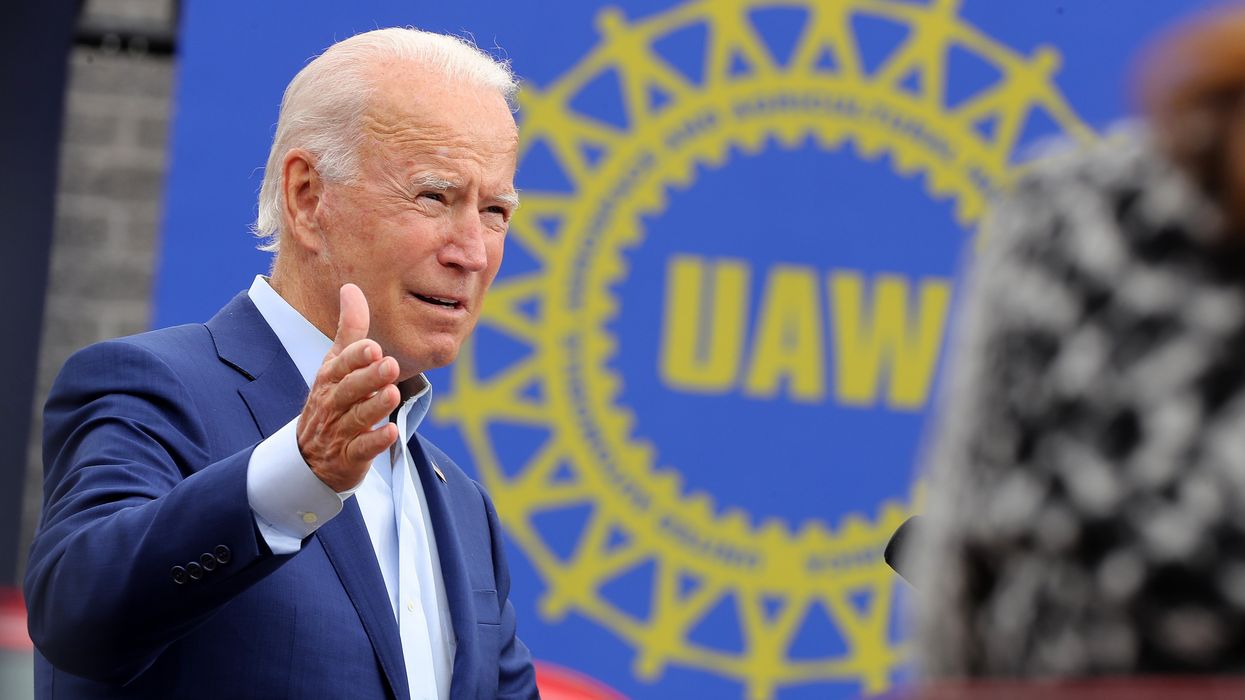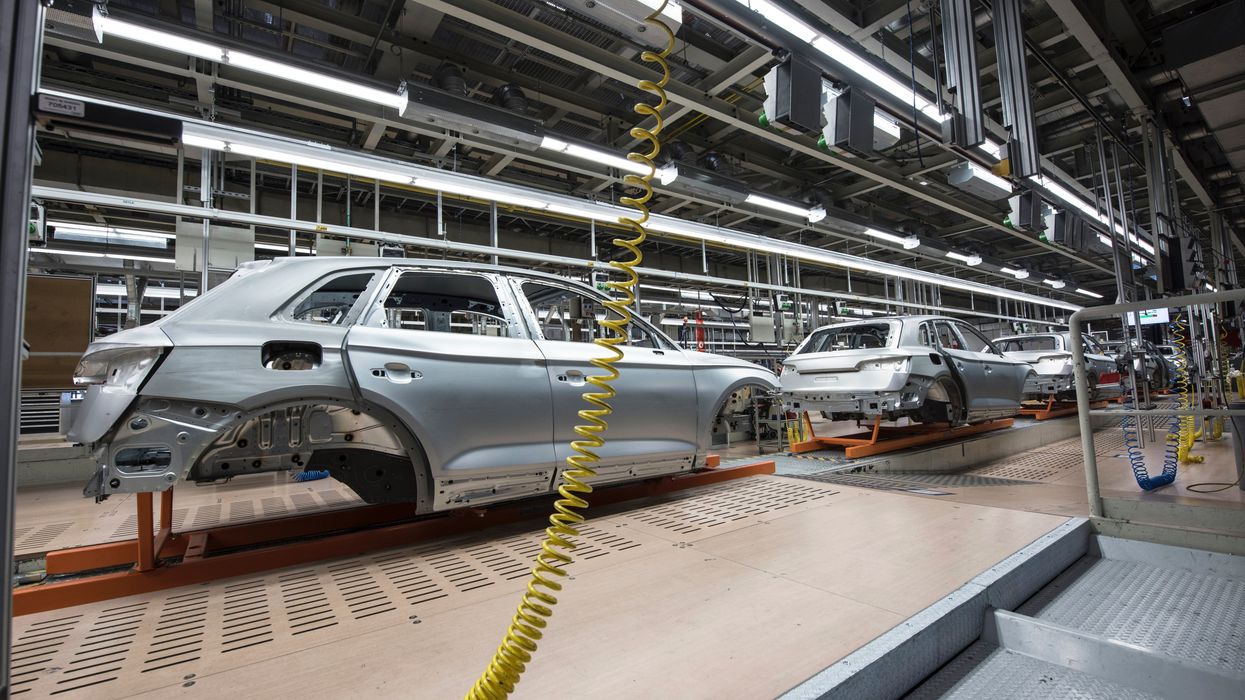Why Biden's Picket Line Solidarity Is a Big Deal—Even Though It Shouldn't Be
Biden’s UAW picket line visit reflects the fact that the strike by union workers is so popular that the leader of the most pro-capitalist country on Earth believed being seen standing alongside them was politically advantageous. That's historic.
On Tuesday, Joe Biden became the first sitting U.S. president to join a picket line when he visited striking United Auto Workers (UAW) members outside a GM parts facility in Belleville, Michigan.
“You guys, UAW, you saved the automobile industry back in 2008 and before. You made a lot of sacrifices, gave up a lot when the companies were in trouble,” the president said to picketing workers. “But now they’re doing incredibly well, and guess what? You should be doing incredibly well too.”
The president has voiced support for the UAW’s strike at the Big Three automakers since it began on September 15. But after former President Donald Trump announced plans to hold a campaign rally at a non-union auto parts plant near Detroit — which the media grossly mischaracterized as “Trump standing with striking autoworkers” — Biden was pushed by fellow Democrats to visit a UAW picket line.
As a candidate in 2019, Biden joined workers on picket lines, including striking GM employees. Candidate Bill Clinton also walked a picket line in 1992, as did candidate Barack Obama in 2007. But no president has ever joined a picket line while in office until today.
On the campaign trail, Obama promised workers that, if elected, he would “put on a comfortable pair of shoes” and “walk on that picket line with you as President of the United States of America” — a promise he never fulfilled. As Obama’s vice president, Biden rebuffed a request from Wisconsin labor leaders in 2011 to join their massive protest against Republican Gov. Scott Walker’s push to curtail public sector union rights.
Biden’s UAW picket line visit reflects the fact that the strike by union workers is so popular that the leader of the most pro-capitalist country on Earth believed being seen standing alongside them was politically advantageous.
“This is absolutely unprecedented. No president has ever walked a picket line before,” labor historian Erik Loomis told the Associated Press.
Labor historian Nelson Lichtenstein similarly told the Guardian, “This is genuinely new — I don’t think it’s ever happened before, a president on a picket line.”
Presidents and picket lines
Almost three years into his term, much ink has been spilled debating whether Biden is living up to his promise to be the “most pro-union president leading the most pro-union administration in American history,” and today’s event will undoubtedly further fuel that discussion.
But what often goes unmentioned is what a low bar it is to earn the distinction of most pro-union president in U.S. history. Far from joining picket lines, most presidents have firmly sided with bosses, if they weren’t bosses themselves.
Twelve U.S. presidents (one in four) were literal slave owners — eight of them while in office. They physically coerced men, women and children to work for them in cruel, excruciating and humiliating conditions with no freedoms and no rights to speak of, let alone compensation.
Several presidents have deployed federal troops to break strikes and crush worker rebellions, including Andrew Jackson in 1834, Rutherford B. Hayes in 1877, Grover Cleveland in 1894, Theodore Roosevelt in 1903 and 1907, and Warren G. Harding in 1921.
Calvin Coolidge’s ascent to the White House was set in motion in 1919 when, as Massachusetts governor, he defeated the unpopular Boston police strike and declared, “There is no right to strike against the public safety by anybody, anywhere, anytime.”
During wars, Presidents Abraham Lincoln, Woodrow Wilson, Franklin D. Roosevelt and Harry S. Truman seized control of certain enterprises or entire industries a total of 71 times to prevent or end strikes — sometimes on the side of unions, sometimes on the side of management.
Since Congress passed the anti-union Taft-Hartley Act in 1947 over President Truman’s veto, the law’s emergency injunction provision — allowing the federal government to shut down strikes in the private sector — has been invoked by presidents 35 times.
Ronald Reagan — the only White House occupant to have previously been a union president and strike leader—infamously fired over 11,000 striking air traffic controllers in 1981 rather than negotiate a new contract with them, setting off the modern era of union busting.
Still, some presidents have also occasionally provided organized labor with moral and tangible support.
In March 1860, as the New England Shoemakers Strike was underway, candidate Abraham Lincoln addressed the situation while campaigning in Hartford, Connecticut. “I know one thing — there is a strike! And I am glad to know that there is a system of labor where the laborer can strike if he wants to,” he said.
Four years later, as the Civil War raged, a printers’ strike in St. Louis was in danger of being broken by U.S. Army troops commanded by General William Rosecrans, who saw labor disputes as impediments to the war effort. The printers appealed to President Lincoln by reminding him of his campaign remarks about the right to strike. Lincoln is said to have ordered Rosecrans to stand down.
President Teddy Roosevelt made history during the anthracite coal strike of 1902 when, instead of simply having the military stamp out the strike, he attempted to mediate a fair resolution by bringing union and management representatives to Washington to negotiate as equals.
During World War I, Woodrow Wilson rewarded union workers with shorter hours, higher wages and better conditions to avoid strikes. But Wilson was also merciless toward anti-war labor radicals, imprisoning many organizers with the Industrial Workers of the World for “obstructing” the war.
Franklin D. Roosevelt is often considered the most pro-labor U.S. president because he oversaw the New Deal — a slew of reforms in the 1930s that uplifted much of the industrial working class, including the pro-union National Labor Relations Act. A famous 1940 union poster quotes FDR as saying, “If I went to work in a factory, the first thing I’d do would be TO JOIN A UNION” — but it’s unclear if he ever actually said this.
“Earned, not freely given”
FDR’s New Deal wouldn’t have been possible without overwhelming Democratic majorities in Congress, a critical advantage not enjoyed by Joe Biden and his stalled Build Back Better agenda.
Nevertheless, Biden has made a decent effort. Under his administration, the National Labor Relations Board (NLRB) has been more unabashedly pro-worker than likely any time since the 1930s. Biden has also followed union leaders’ wishes on who to elevate into key positions such as Secretary of Labor and NLRB general counsel, and has used his bully pulpit to make some of the most pro-union public statements we’ve ever heard from a president (again, it’s a low bar.)
At the same time, Biden has so far failed to get Congress to pass the union-friendly PRO Act, though he was all too successful in getting Congress to preempt last year’s potential railroad strike and impose an unpopular contract on rail workers despite a majority of them voting to reject it. Anti-union actions like overriding rank-and-file democracy and denying workers’ their fundamental right to strike are unfortunately par for the course for U.S. presidents.
This seems to be something UAW President Shawn Fain understands. Just as Fain refused to engage in the traditional, ceremonial handshake with the Big Three CEOs at the start of contract bargaining, he and his union have so far refrained from endorsing Biden’s reelection (while 17 other unions and the AFL-CIO quickly endorsed him back in June).
“Our endorsements are going to be earned, not freely given,” Fain has said. This example of labor proudly standing up for itself and demanding respect, instead of reflexively bowing to those in power, likely encouraged Biden to make history by joining the picket line today. It may also be what ultimately forces the Big Three to make historic concessions to striking autoworkers.

